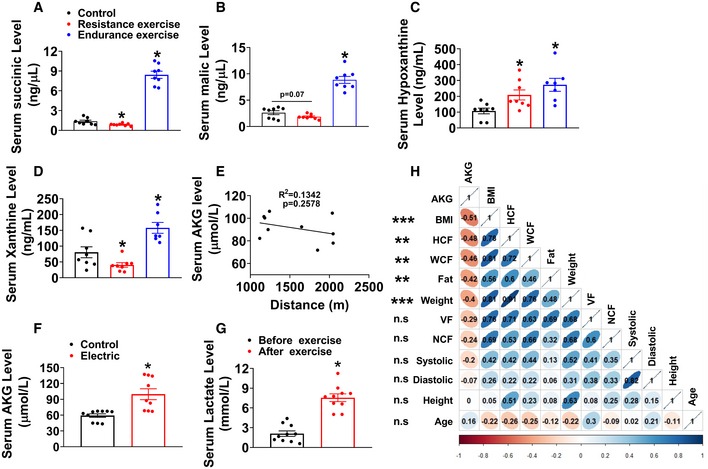-
A–D
The serum concentration of succinic acid (A), malic acid (B), hypoxanthine (C), and xanthine (D) in mice. Chow‐fed male C57BL/6 mice (10 weeks old) were divided into three groups receiving non‐exercise, endurance exercise (treadmill, 10 m/min, increased by 2 m/min every 2 min to exhaustion), or resistance exercise (ladder‐climbing for 40 min) (n = 8 per group).
-
E
Two‐tailed Pearson's correlation coefficient analysis of plasma AKG level and the running distance of wheels. Chow‐fed male C57BL/6 mice (10 weeks old) received 1‐day free access to running wheel (n = 10 per group).
-
F
Serum AKG level after electrical stimulation. Electrical stimulation was performed in unilateral gastrocnemius for 40 min (1 ms width/50 Hz, 10 times, each time for 4 min, resting for 2 min between stimulations) in vivo in 10‐week‐old male C57BL/6 mice fed with chow diet (n = 8‐9 per group).
-
G
Serum lactate concentration. Chow‐fed male C57BL/6 mice (10 weeks old) received resistance exercise for 40 min. The serum lactate concentration was tested before and immediately after exercise (n = 10 per group).
-
H
Two‐tailed Pearson's correlation coefficient analysis of human plasma AKG level and body mass index (BMI), hip circumference (HCF), waist circumference (WCF), fat mass, body weight, visceral fat (VF), neck circumference (NCF), systolic pressure, diastolic pressure, height, and age. **P ≤ 0.01 and ***P ≤ 0.001 indicate significant correlation between human plasma AKG level and BMI, HCF, WCF, fat mass, and body weight by one‐way ANOVA followed by post hoc Tukey's tests. Red: negative correlation; blue: positive correlation.
Data information: Results are presented as mean ± SEM. In (A–D and G), *
≤ 0.05 by one‐way ANOVA followed by post hoc Tukey's tests.

